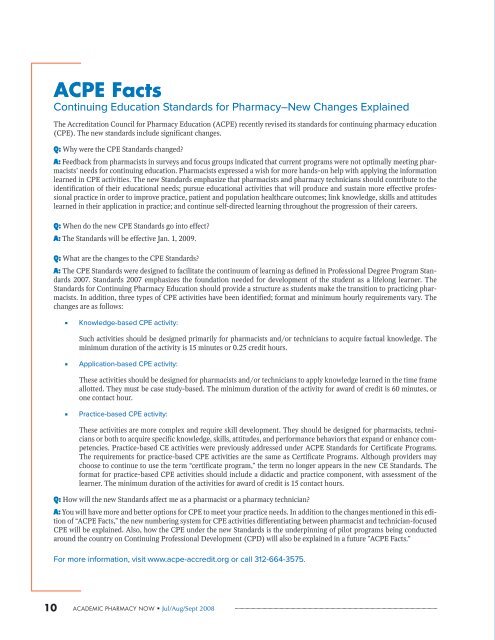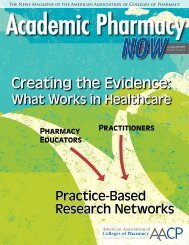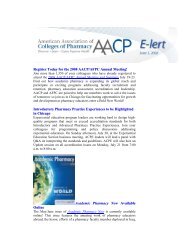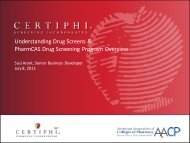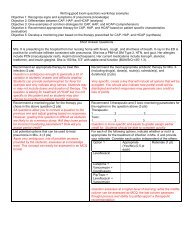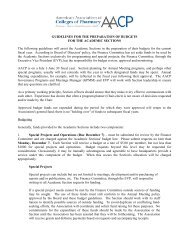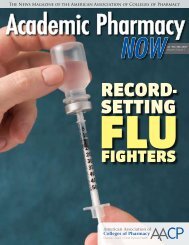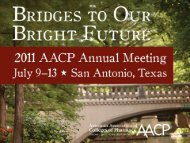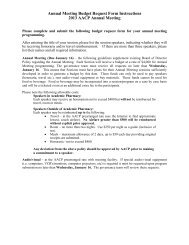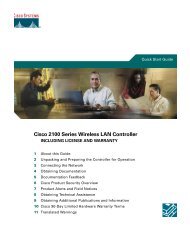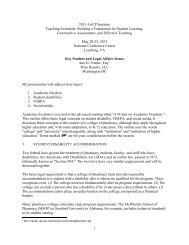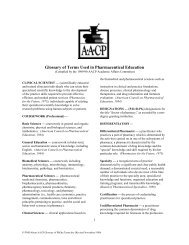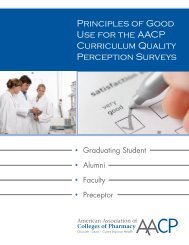Jul Aug 2008 APN.pdf - AACP
Jul Aug 2008 APN.pdf - AACP
Jul Aug 2008 APN.pdf - AACP
You also want an ePaper? Increase the reach of your titles
YUMPU automatically turns print PDFs into web optimized ePapers that Google loves.
ACPE Facts<br />
Continuing Education Standards for Pharmacy–New Changes Explained<br />
The Accreditation Council for Pharmacy Education (ACPE) recently revised its standards for continuing pharmacy education<br />
(CPE). The new standards include significant changes.<br />
Q: Why were the CPE Standards changed?<br />
A: Feedback from pharmacists in surveys and focus groups indicated that current programs were not optimally meeting pharmacists’<br />
needs for continuing education. Pharmacists expressed a wish for more hands-on help with applying the information<br />
learned in CPE activities. The new Standards emphasize that pharmacists and pharmacy technicians should contribute to the<br />
identification of their educational needs; pursue educational activities that will produce and sustain more effective professional<br />
practice in order to improve practice, patient and population healthcare outcomes; link knowledge, skills and attitudes<br />
learned in their application in practice; and continue self-directed learning throughout the progression of their careers.<br />
Q: When do the new CPE Standards go into effect?<br />
A: The Standards will be effective Jan. 1, 2009.<br />
Q: What are the changes to the CPE Standards?<br />
A: The CPE Standards were designed to facilitate the continuum of learning as defined in Professional Degree Program Standards<br />
2007. Standards 2007 emphasizes the foundation needed for development of the student as a lifelong learner. The<br />
Standards for Continuing Pharmacy Education should provide a structure as students make the transition to practicing pharmacists.<br />
In addition, three types of CPE activities have been identified; format and minimum hourly requirements vary. The<br />
changes are as follows:<br />
•<br />
•<br />
•<br />
Knowledge-based CPE activity:<br />
Such activities should be designed primarily for pharmacists and/or technicians to acquire factual knowledge. The<br />
minimum duration of the activity is 15 minutes or 0.25 credit hours.<br />
Application-based CPE activity:<br />
These activities should be designed for pharmacists and/or technicians to apply knowledge learned in the time frame<br />
allotted. They must be case study-based. The minimum duration of the activity for award of credit is 60 minutes, or<br />
one contact hour.<br />
Practice-based CPE activity:<br />
These activities are more complex and require skill development. They should be designed for pharmacists, technicians<br />
or both to acquire specific knowledge, skills, attitudes, and performance behaviors that expand or enhance competencies.<br />
Practice-based CE activities were previously addressed under ACPE Standards for Certificate Programs.<br />
The requirements for practice-based CPE activities are the same as Certificate Programs. Although providers may<br />
choose to continue to use the term “certificate program,” the term no longer appears in the new CE Standards. The<br />
format for practice-based CPE activities should include a didactic and practice component, with assessment of the<br />
learner. The minimum duration of the activities for award of credit is 15 contact hours.<br />
Q: How will the new Standards affect me as a pharmacist or a pharmacy technician?<br />
A: You will have more and better options for CPE to meet your practice needs. In addition to the changes mentioned in this edition<br />
of “ACPE Facts,” the new numbering system for CPE activities differentiating between pharmacist and technician-focused<br />
CPE will be explained. Also, how the CPE under the new Standards is the underpinning of pilot programs being conducted<br />
around the country on Continuing Professional Development (CPD) will also be explained in a future ”ACPE Facts.”<br />
For more information, visit www.acpe-accredit.org or call 312-664-3575.<br />
Capitol Hill News<br />
news b r i e f s<br />
10 academic Pharmacy now <strong>Jul</strong>/<strong>Aug</strong>/Sept <strong>2008</strong><br />
academic Pharmacy now <strong>Jul</strong>/<strong>Aug</strong>/Sept <strong>2008</strong> 11<br />
by Will Lang<br />
Room for Improvement Through<br />
National Policy Initiatives<br />
The Medicare Modernization Act of 2003 (MMA)<br />
provides another opportunity for the pharmacy profession<br />
to improve and strengthen its social contract<br />
as the learned intermediary with patients, prescribers<br />
and payers. While this Medicare Part D requirement is<br />
limited in its beneficiary reach and extremely flexible in<br />
its requirements of providers, the Centers for Medicare<br />
and Medicaid Services (CMS) is increasing its evaluation<br />
of these programs and therefore provides a developing<br />
evidence base for the quality improvement associated<br />
with integrating the pharmacist into collaborative medication<br />
management service provision.<br />
<strong>AACP</strong> was among the many organizations that advocated<br />
for the Medicare Part D benefit to be a much more<br />
robust platform for pharmacist-provided medication<br />
management. Part of that platform included, and still<br />
does today, payment for pharmacy services under Medicare<br />
Part B. Despite a strong and sustained advocacy<br />
effort, the Part D benefit MTM provision resolved to its<br />
rather weak statutory language due to:<br />
•<br />
•<br />
•<br />
the lack of a sufficient, rigorous evidence base of the<br />
value of the pharmacist in medication management;<br />
insufficient appreciation of the changes in the<br />
education of the pharmacist; and<br />
program cost estimates leading some to discern<br />
changes may be ill-considered or indiscriminate.<br />
Even with leadership changes within CMS, the MTM<br />
program remains a priority for CMS to:<br />
•<br />
•<br />
•<br />
increase the evaluation;<br />
improve the quality; and<br />
create a more consistent approach to Part D plan<br />
MTM delivery.<br />
The most recent guidance published by CMS for Part<br />
D plans regarding MTM program delivery in <strong>2008</strong> is<br />
illuminating in its direct statements of recognizing the<br />
importance of medication therapy management to<br />
improved quality of care for Medicare beneficiaries. To<br />
view the Medicare Part D MTM Programs <strong>2008</strong> FACT<br />
SHEET go to www.cms.hhs.gov/PrescriptionDrugCov-<br />
Contra/Downloads/MTMFactSheet.<strong>pdf</strong>.<br />
The Part D MTM programs provide ample advocacy<br />
opportunities for academic pharmacy in a number of<br />
areas.<br />
1.<br />
2.<br />
Research<br />
Will<br />
on<br />
the<br />
Hill<br />
The need for solid, quantitative data still remains<br />
to move patients, policy makers, prescribers, and<br />
payers from their traditional images and utilization<br />
of the pharmacist. Two areas of health services<br />
research that can help change this traditional image<br />
are comparative effectiveness research (CER) and<br />
the development of quality indicators. The potential<br />
for pharmacy faculty to move the profession<br />
from behind the counter will increase dramatically<br />
through research that compares healthcare practices<br />
that include or do not include the pharmacist as<br />
part of the medication management team. Both the<br />
Institute of Medicine and the Agency for Healthcare<br />
Research and Quality are engaged in discussions<br />
and support CER. The creation of quality indicators<br />
requires development and testing for which<br />
pharmacy faculty are well qualified. The Pharmacy<br />
Quality Alliance is an example of pharmacy faculty<br />
driving the development of pharmacy-focused<br />
quality indicators that are intended to move payers<br />
toward payment for quality MTM services. For more<br />
information, visit www.pqaalliance.org.<br />
Improving MTM<br />
It is clear that the Medicare Part D benefit is limited<br />
in its reach and therefore its impact. According<br />
to CMS, just “10 percent of beneficiaries enrolled<br />
in Plans with a Medication Therapy Management<br />
Program (MTMP) met the Plan’s designated MTMP<br />
criteria.” Yet the use of community-based pharmacists<br />
to provide MTM by Part D plans has doubled<br />
from 10 percent in 2007 to 20 percent in <strong>2008</strong>.<br />
Toward the end of creating a more robust MTM<br />
program, pharmacy organizations, including <strong>AACP</strong>,<br />
have organized through the Leadership for Medication<br />
Management (LMM). The two pronged strategy<br />
for the LMM is to create a Part D funded yearly drug<br />
review for all Medicare beneficiaries and the provision<br />
of additional medication management services<br />
that would be paid for through Medicare Part B.<br />
The 111th Congress will provide ample opportunity for<br />
pharmacy faculty to be engaged in federal efforts to<br />
improve the quality of care through medication management<br />
for all Americans. Preparing for this engagement<br />
now by enhancing the evidence for our arguments<br />
through research is essential.


